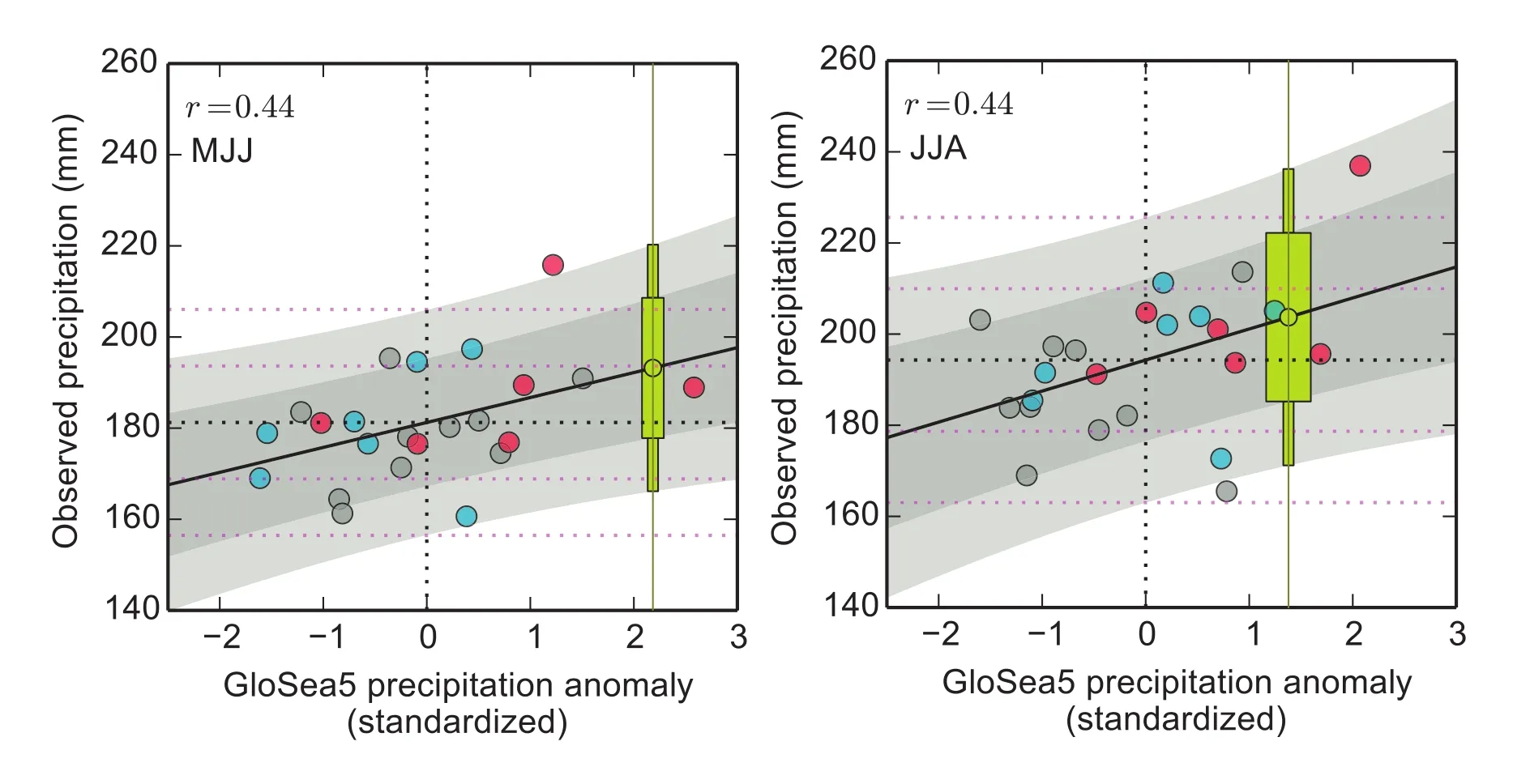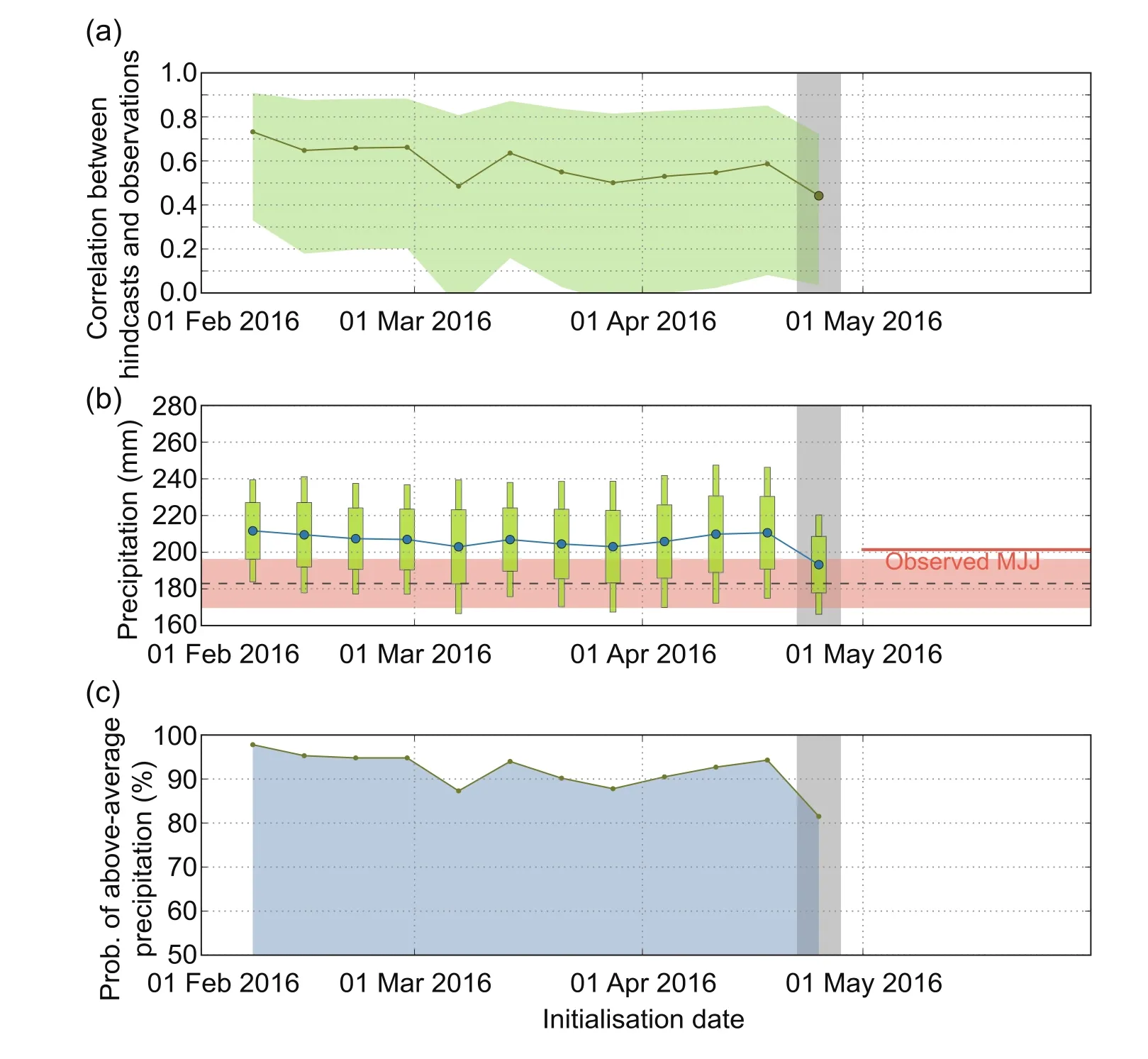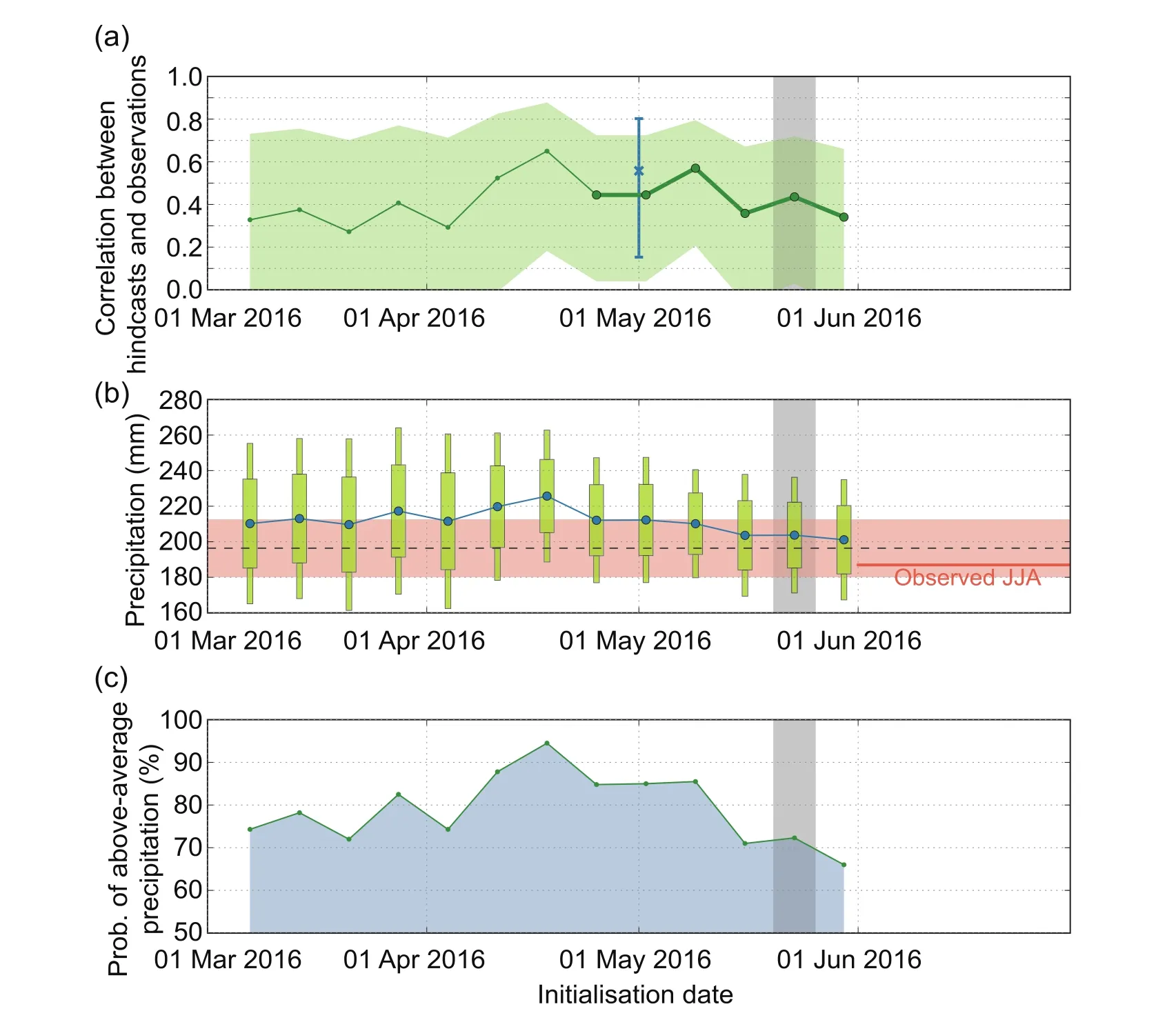Seasonal Forecasts of the Summer 2016 Yangtze River Basin Rainfall
2018-06-20PhilipBETTAdamSCAIFEChaofanLIChrisHEWITTNicolaGOLDINGPeiqunZHANGNickDUNSTONEDougSMITHHazelTHORNTONRiyuLUandHongLiREN
Philip E.BETT,Adam A.SCAIFE,Chaofan LI,Chris HEWITT,Nicola GOLDING,Peiqun ZHANG,Nick DUNSTONE,Doug M.SMITH,Hazel E.THORNTON,Riyu LU,and Hong-Li REN
1 Met Office Hadley Centre,FitzRoy Road,Exeter EX1 3PB,UK
2 College of Engineering,Mathematics and Physical Sciences,University of Exeter,Exeter,Devon EX4 4QF,UK
3 Center for Monsoon System Research,Institute of Atmospheric Physics,Chinese Academy of Sciences,Beijing 100029,China
4 Laboratory for Climate Studies,National Climate Center,China Meteorological Administration,Beijing 100081,China
5 State Key Laboratory of Numerical Modeling for Atmospheric Sciences and Geophysical Fluid Dynamics,Institute of Atmospheric Physics,Chinese Academy of Sciences,Beijing 100029,China
1.Introduction
The Yangtze River basin cuts across central China,providing water,hydroelectricity and agricultural land for millions of people.The Yangtze has been subject to flooding throughout history(e.g.,Plate,2002;Yu et al.,2009),linked to variations in the East Asian monsoon that are sometimes driven by factors such as the El Niño–Southern Oscillation(ENSO;e.g.Zhang et al.,2016a,b).Large hydroelectric dams along the river and its tributaries,such as the Three Gorges Dam(Jiao et al.,2013),have flood defense as their primary responsibility.However,by lowering the water level behind the dam to protect against flooding,less electricity will be produced.There are therefore clear benefits of forecasting impactful rainfall events at long lead times,allowing mitigation planning for flooding and electricity production.
The relationship between ENSO and the East Asian monsoon is complex and not fully understood.However,it has long been clear that a strong El Niño peaking in winter is likely to be followed by above-average rainfall in China the following summer(e.g.,Stuecker et al.,2015;He and Liu,2016;Xie et al.,2016;Zhang et al.,2016a,b),although this response is not symmetric under La Niña conditions(Hardiman et al.,2017).The extreme El Niño event of 1997/98 was followed by devastating floods in the Yangtze River basin(Zong and Chen,2000;Ye and Glantz,2005;Yuan et al.,2017):thousands of people died,millions were made homeless,and the economic losses ran into billions of CNY.In the subsequent years,much work has gone into better water management and flood prevention,and into improving both the accuracy and communication of climate forecasts,to prevent such a disaster happening again.
Seasonal rainfall forecasts across China have long been produced based on statistical relationships with large-scale climate phenomena,rather than forecasting precipitation di-rectly from dynamical models.For example,Zhu et al.(2008)and Li and Lin(2015)both examined the skill of 500 hPa geopotential height(z500)data,from multi-model ensembles of dynamical seasonal forecast systems,for forecasting summer monsoon and Yangtze river valley rainfall,respectively.Tung et al.(2013),however,found that using sea level pressure performed betterthan usingz500when forecasting station-scale summer rainfall in southern China.Kwon et al.(2009),Peng et al.(2014),Wu and Yu(2016),Xing et al.(2016)and Zhang et al.(2016b)all investigated different statistical approaches to forecasting summer precipitation in China,based on various observational indices derived from sea surface temperatures(SSTs),air temperature and pressure.In many cases,these showed an improvement over dynamical models.Wang et al.(2013)found that both dynamical models and a statistical model based on SSTs and pressure were able to predict the variability in the West Pacific subtropical high,which was itself shown to be a good predictor of East Asian summer monsoon rainfall.Statistical downscaling techniques have also been shown to improve predictions of summer precipitation in China over global dynamical forecast models(e.g.,Ke et al.,2011;Liu and Fan,2012).
Recent advances in the dynamical seasonal forecast system developed at the UK Met Office,GloSea5(MacLachlan et al.,2015),have resulted in the development of operational and prototype climate services for the UK in many sectors(e.g.,Svensson et al.,2015;Palin et al.,2016;Clark et al.,2017).Recent work has shown that GloSea5 also has useful levels of skill for various processes in China(Bettetal.,2017;Lu et al.,2017),including for summer precipitation over the Yangtze River basin(Li et al.,2016),without having to use statistical models based on larger-scale drivers.
In parallel to these findings,Golding et al.(2017)demonstrated that there was a clear demand from users for improved seasonal forecasts for the Yangtze,both from the flood risk and hydro power production communities.The very strong El Niño that developed during the winter of 2015/16(Zhai et al.,2016)provided a perfect opportunity to develop a trial operational seasonal forecast using GloSea5 for the subsequent summer of 2016.
We therefore produced forecasts for the upcoming three month period each week,from February(forecasting March–April–May)to the end of July 2016(forecasting August–September–October);our focus,however,was on forecasting the June–July–August(JJA)period,as that was where Li et al.(2016)had demonstrated skill.In the last week of each month,a forecast for the coming season was issued by the Met Office to the China Meteorological Administration(CMA).
In this paper,we describe the observed rainfall in the Yangtze region in summer 2016,and assess how the real-time forecasts for May–June–July(MJJ)and JJA performed,with a range of lead times from zero to three months.We describe in section 2 the datasets used,and in section 3 our forecast production methodology.In section 4 we compare the forecasts to the observed behavior,and in section 5 discuss possible future developments.
2.Datasets
The current operational version of Glo Sea5(MacLachlan et al.,2015)is based on the Global Coupled 2(GC2)configuration of the HadGEM3 global climate model,described in detail in Williams et al.(2015)and references therein.Within HadGEM3-GC2,the atmospheric component[the Met Office Unified Model(Walters et al.,2017)]is coupled to the JULES land surface model(Best et al.,2011),the NEMO ocean model(Madec,2008;Megann et al.,2014)and the CICE sea ice model(Hunke and Lipscomb,2010;Rae et al.,2015).The atmosphere is modelled on a grid of 0.83◦in longitude and 0.55◦in latitude,with 85 levels vertically,including a well-resolved stratosphere;the ocean model is modelled on a 0.25◦horizontal grid,with 75 levels vertically.
Using this configuration,GloSea5 runs operationally,producing both forecasts and corresponding hindcasts(intended to bias-correct the forecasts).Each day,two initialized forecasts are produced,running out to seven months.To produce a complete forecast ensemble for a given start date,the last three weeks of individual forecasts are collected together to form a 42-member lagged forecast ensemble.
At the same time,an ensemble of hindcasts is produced each week.As described by MacLachlan et al.(2015),three members are run from each of four fixed initialization dates in each month(the 1st,9th,17th and 25th),for each of the 14 years covering 1996–2009.The full hindcast ensemble is made by collecting together the four hindcast dates nearest to the forecast start date,yielding a 12-member,14-year hindcast.Note that the hindcast was extended at the end of April 2016 to cover 23 years(1993–2015).
This operational hindcast is not intended to be used for skill assessments:with only 12 members,skill estimates would be biased low(Scaife et al.,2014).However,a separate,dedicated hindcast was produced for skill assessment,with 24 members and 20 years.Using that hindcast,we find a correlation skill of 0.56 for summer Yangtze rainfall,statistically indistinguishable from the previous value of 0.55 found by Li et al.(2016).
We use precipitation data from the Global Precipitation Climatology Project(GPCP)as our observational dataset.This is derived from both satellite data and surface rain gauges,covering the period from 1979 to the present at a spatial resolution of 2.5◦(Adler et al.,2003).The verification we present here uses version 2.3 of the data(Adler et al.,2016).Only version 2.2 was available when we started our operational trial,although we have confirmed that the choice of version 2.2 or 2.3 makes negligible difference to our forecasts or results.
3.Forecast production
Typically,when producing a seasonal forecast,the distribution of forecast ensemble members is used to repre-sent the forecast probability distribution directly.However,experience has shown that the GloSea5 ensemble members may contain anomalously small signals,such that the predictable signal only emerges through averaging a large ensemble(Eade et al.,2014;Scaife et al.,2014).While this effect is less pronounced in subtropical regions like the Yangtze Basin,it is still present(Li et al.,2016).
We therefore implemented a simple precipitation forecasting methodology,based entirely on the historical relationship between the hindcast ensemble means and the observed precipitation,averaged over the Yangtze River basin region(25◦–35◦N,91◦–122◦E),following Li et al.(2016),for the season in question.The prediction intervals,derived from the linear regression of the hindcasts to the observations(e.g.,Wilks,2011),provide a calibrated forecast probability distribution.
This is illustrated in Fig.1,where we show the precipitation forecasts issued in late April for MJJ,and in late May for JJA.The distribution of hindcasts and observations is shown as a scatter plot,with the ensemble mean forecast also included as a green circle.The uncertainty in the linear regression(gray)determines the forecast probabilities(green bars).The GloSea5 data are shown in standardized units—that is,the anomaly of each year from the mean,as a fraction of the standard deviation of hindcast ensemble means.The observations on the vertical axis are presented as seasonal means of monthly precipitation totals.The relationship with ENSO is indicated though color-coding of the hindcast points:years are labelled as El Niño(red)or La Niña(blue)according to whether their Oceanic Niño Index(http://www.cpc.noaa.gov/products/analysismonitoring/ensostuff/ensoyears.shtml),based on observed SST anomalies in the Niño3.4 region,is above 0.5 K or below−0.5 K,respectively.

Fig.1.Forecasts for MJJ(produced 25 April 2016)and JJA(produced 23 May 2016),as labeled,using GPCP observations.Observation/hindcast points are color-coded according to their observed winter ENSO index:red points are El Niño years,blue points are La Niña years,and gray points are neutral.The horizontal width of the green forecast bars is the standard error on the ensemble mean,i.e.,the forecast ensemble spread divided by the number of ensemble members.The 75%and 95%prediction intervals are shown as gray shading.The variability in the observations is indicated by the pink horizontal dotted lines,at±1 and 2 standard deviations.The correlation r between hindcast and observations is marked on each panel(coincidentally the same when rounded).
Forecasts like those shown in Fig.1 were produced each Monday starting in February 2016,using the forecast model runs initialized each day of the preceding three weeks to generate the 42-member ensemble,and the four nearest weeks of hindcast runs for the 12-member hindcast ensemble.The forecast produced near the end of each month was issued to the CMA:the MJJ release was produced on 25 April and the JJA release on 23 May.
It is important to note that,due to the linear regression method we employ,our forecast probabilities are explicitly linked to both the hindcasts and the observations.The correlations between hindcasts and observations are biased low due to the smaller size of the hindcast ensemble compared to the forecast ensemble—a larger hindcast ensemble would not necessarily alter the gradient of the linear regression,but would reduce its uncertainty.Our forecast probabilities are therefore conservative(likely to be too small).
The forecast information provided was designed to show very clearly and explicitly the uncertainties in the forecast system,to prevent overconfidence on the part of potential decision-makers.In addition to the scatterplot showing the forecast and the historical relationship(Fig.1),we also provided the probability of above-average precipitation as a“headline message”.This was accompanied by a contingency table showing the hit rate and false alarm rate for above-average forecasts over the hindcast period.For the MJJ and JJA forecasts,these are shown in Tables 1 and 2.

Table 1.Contingency table for forecasts of above-average precipitation for the Yangtze region in MJJ,produced on 25 April 2016.The event counts are based on the GPCP observations and ensemble mean hindcasts shown in Fig.1.The hit rate is the ratio of the number of hits to the number of times above-average conditions were observed.The false alarm rate is the ratio of the number of false alarms to the total number of observed below-average years.

Table 2.Contingency table for forecasts of above-average precipitation in JJA,produced on 23 May 2016,similar to Table 1.
To assess the sensitivity of our results to individual years,we have performed leave-one-out cross-validation for the MJJ and JJA forecasts.We find that the correlation between hindcasts and observations in the case of each left-out year does not vary much:75%of the cases have correlations between 0.41 and 0.47.However,leaving out 1998 does reduce the performance,as expected:the correlation over the remaining 22 years in that case reduces tor=0.37(MJJ)andr=0.24(JJA),and the observed value falls outside the 95%prediction range of the forecasts;our procedure does require similar signals to be present in the hindcast period in order to calibrate the forecasts.Note that this cross-validation procedure is not directly analogous to our actual forecasts:with only 12 members per year,the hindcast ensemble means are much more uncertain than ouractual42-member forecasts for 2016,and our cross-validation does not account for this.
4.Results
The observed precipitation in May,June,July and August 2016 is shown in Fig.2.We use standardized units here to show the precipitation anomaly relative to the historical variability over the hindcast period(1993–2015).It is clear that the most anomalously high rainfall was in May and June,and largely in the eastern half of the basin.July was close to normal overall when considering the box we were forecasting for,although there were disastrous floods further north.August had anomalously low rainfall across most of the region.Yuan et al.(2017)examined the observed summer 2016 rainfall in China and the Yangtze River basin in detail,including its relationship to larger-scale drivers:the anomalously low rainfall in August 2016 is in marked contrast to the situation in 1998,and is related to the behavior of Indian Ocean temperatures and the Madden–Julian Oscillation(MJO)during the summer.
Figures 3 and 4 show the three-month mean precipitation anomalies for MJJ and JJA respectively,for both GPCP and the forecast averages from the GloSea5 model output.While we do not expect the spatial patterns to match in detail[considering the skill maps of Li et al.(2016)],the overall signal is similar to the observations,with stronger anomalous precipitation in the eastern region in MJJ,and closer-to-average precipitation in JJA.
We examine our forecasts for the Yangtze basin box more quantitatively in Figs.5 and 6,where we show the variation with lead time of the hindcast–observation correlation,the 2016 forecast signal,and the probability of above-average precipitation,for MJJ and JJA respectively.Neither the hindcast–observation correlation nor the forecast signal vary significantly with lead time;indeed,they are remarkably consistent back to three months before the forecast season,and when the 23-year hindcast is introduced at the end of April.
The forecasts did a good job of giving an indication of precipitation in the coming season.For MJJ,the forecast gave a high probability of above-average precipitation(80%),and it was observed to be above average.In JJA,the mean precipitation was observed to be slightly below average,due to the strong drier-than-average signal in August,although it was within a standard deviation of the interannual variability.While our forecast marginally favored wetter than average conditions(65%probability of above-average rainfall),it was correctly near to the long-term mean,and the observed value was well within the forecast uncertainties.
5.Discussion and conclusions
The heavy rainfall in the Yangtze River region in early summer 2016 was at a similar level to that of 1998,and caused heavy flooding(WMO,2017;Yuan et al.,2017).While deaths due to the flooding were roughly an order of magnitude fewer than those caused by the 1998 floods(i.e.,hundreds rather than thousands of lives),the economic losses nevertheless ran into tens of billions of CNY.Furthermore,it was reported that insurance claims,mostly from agricultural losses,amounted to less than 2%of the total economic loss,suggesting significant levels of underinsurance(Podlaha et al.,2016).The prior experience of the 1998 El Niño-enhanced flooding,and the high levels of awareness of the strong El Niño in winter 2015/16,meant that dams along the Yangtze were prepared in anticipation of high levels of rain-fall.Our forecasts from GloSea5,produced using the simple methodology described here,contributed to the confidence of users adapting to the impending rainfallaGolding,N.,C.Hewitt,P.Bett,M.Liu,and P.Zhang:Co-Development of a Seasonal Forecast Climate Service:Supporting flood risk management for the Yangtze River Basin.(in preparation).

Fig.2.Observed precipita Golding,N.,C.Hewitt,P.Bett,M.Liu,and P.Zhang:Co-Development of a Seasonal Forecast Climate Service:Supporting flood risk management for the Yangtze River Basin.(in preparation)tion from GPCP(version 2.3)for May,June,July and August(as labeled),in standardized units with respect to the 1993–2015 period.The Yangtze box used for the forecasts is marked as a red rectangle,with a pink polygon showing the physical Yangtze River catchment.Major rivers are marked in blue.

Fig.3.Mean precipitation for 2016-MJJ in the GPCP observations and GloSea5 forecast signal,(as labeled),in standardized units.The GloSea5 data have been regridded to match the lower-resolution observations.

Fig.4.Mean precipitation for 2016-JJA in the GPCP observations and GloSea5 forecast signal,(as labeled),in standardized units.The GloSea5 data have been regridded to match the lower-resolution observations.

Fig.5.Time series showing the behavior of the MJJ forecasts and hindcasts with lead time:(a)Correlation between observations and the operational hindcasts available each week.The final point was produced using 23 years,whereas only 14 were available before that.The shading indicates 95%confidence intervals using the Fisher Z-transformation.(b)The forecast signal shown as 95%and 75%prediction intervals(boxes)and the ensemble mean(blue line).The observed precipitation is marked as an orange horizontal line from May.The observed historical mean and standard deviation over the hindcast period are marked as a dashed line and orange shading respectively.(c)The forecast probability of above-average precipitation.The final forecast issued for MJJ,produced 25 April,is highlighted with a gray vertical bar.

Fig.6.Time series showing the behavior of the JJA forecasts and hindcasts with lead time,following the same format as Fig.5.In(a)(hindcast–observations correlation),the line becomes thicker when 23 years of hindcasts are available.We mark with a blue cross and error bar the correlation skill derived from the assessment hindcast(see text for details).The final forecast issued for JJA,on 23 May,is highlighted across all panels.
Our verification has shown that our forecasts gave a good indication of the observed levels of precipitation for both MJJ and JJA averages over the large Yangtze Basin region.A greater degree of both spatial and temporal resolution—splitting the basin into upper and lower sections,and producing additional forecasts at a monthly timescale—would of course be preferable to users.However,smaller regions and shorter time periods may well be less skillful,so further work is needed to assess how best to achieve skillful forecasts in these cases.
One significant improvement would be to increase the ensemble size of the hindcast.During 2017 the GloSea5 system was changed from three hindcast members per start date to seven.This could result in noticeable improvements in forecasts like those described here,as the hindcast–observations relationship will be less uncertain,especially when a predictable signal is present,such as from El Niño.Improvements in the underlying climate model,such as to parametrized convective precipitation,and the simulation of the monsoon and features like the MJO,could also improve the forecast skill.
We will be issuing forecasts again in 2017.However,unlike 2016,in 2017 there are no strong drivers,such as El Niño.Nevertheless,understanding the behavior of the forecast system under such conditions will be informative,for both the users and the producers of the forecasts.Ultimately,trial climate services such as this help to drive forecast development,improve understanding of forecast uncertainties,and promote careful use by stakeholders in affected areas.
Acknowledgements.This work and its contributors(PB,AS,ND,DS,CH,NG)were supported by the UK–China Research&Innovation Partnership Fund through the Met Office Climate Science for Service Partnership China as part of the Newton Fund.CL and RL were supported by the National Natural Science Foundation of China(Grant No.41320104007).HR was supported by the Project for Development of Key Techniques in Meteorological Operation Forecasting(Grant No.YBGJXM201705).The trial forecast service was first suggested by AS in 2015.The GPCP precipitation data were provided by the NOAA/OAR/ESRL PSD,Boulder,Colorado,USA,via their website at http://www.esrl.noaa.gov/psd/.The Yangtze River basin shape file used in the maps was obtained from http://worldmap.harvard.edu/data/geonode:ch_wtrshed 30mar11 and is based on the watersheds shown in the China Environmental Atlas(2000),©Chinese Academy of Sciences,Environmental Data Center.
REFERENCES
Adler,R.,and Coauthors,2016:The new version 2.3 of the Global Precipitation Climatology Project(GPCP)monthly analysis product.University of Maryland.[Available online from http://eagle1.umd.edu/GPCP_ICDR/GPCP_Monthly.html]
Adler,R.F.,and Coauthors,2003:The version-2 Global Precipitation Climatology Project(GPCP)monthly precipitation analysis(1979–Present).Journal of Hydrometeorology,4,1147–1167,https://doi.org/10.1175/1525-7541(2003)004<1147:TVGPCP>2.0.CO;2.
Best,M.J.,and Coauthors,2011:The Joint UK Land Environment Simulator(JULES),model description—Part 1:Energy and water fluxes.Geoscientific Model Development,4,677–699,https://doi.org/10.5194/gmd-4-677-2011.
Bett,P.E.,and Coauthors,2017:Skill and reliability of seasonal forecasts for the Chinese energy sector.Journal of Applied Meteorology and Climatology,56,3099–3114,https://doi.org/10.1175/jamc-d-17-0070.1.
Clark,R.T.,P.E.Bett,H.E.Thornton,and A.A.Scaife,2017:Skillful seasonal predictions for the European energy industry.Environmental Research Letters,12,024002,https://doi.org/10.1088/1748-9326/aa57ab.
Eade,R.,D.Smith,A.Scaife,E.Wallace,N.Dunstone,L.Hermanson,and N.Robinson,2014:Do seasonal-to-decadal climate predictions underestimate the predictability of the real world?Geophys.Res.Lett.,41,5620–5628,https://doi.org/10.1002/2014gl061146.
Golding,N.,C.Hewitt,P.Q.Zhang,P.Bett,X.Y.Fang,H.Z.Hu,and S.Nobert,2017:Improving user engagement and uptake of climate services in China.Climate Services,5,39–45,https://doi.org/10.1016/j.cliser.2017.03.004.
Hardiman,S.,and Coauthors,2017:The asymmetric response of Yangtze River basin summer rainfall to El Niño/La Niña.Environmental Research Letters,https://doi.org/10.1088/1748-9326/aaa172.(in press)
He,J.H.,and B.Q.Liu,2016:The East Asian subtropical summer monsoon:Recent progress.Journal of Meteorological Research,30,135–155,https://doi.org/10.1007/s13351-016-5222-z.
Hunke,E.C.,and W.H.Lipscomb,2010:CICE:The Los Alamos Sea Ice model documentation and software user’s manual,version 4.1.Report LA-CC-06-012,Los Alamos National Laboratory.[Available online from http://oceans11.lanl.gov/trac/CICE]
Jiao,M.Y.,and Coauthors,2013:Addressing the potential climate effects of China’s Three Gorges Project.WMO Bulletin,62(Special Issue),49–53.[Available online from http://library.wmo.int/opac/index.php?lvl=bulletin_display&id=2738]
Ke,Z.J.,P.Q.Zhang,L.J.Chen,and L.M.Du,2011:An experiment of a statistical downscaling forecast model for summer precipitation over China.Atmospheric and Oceanic Science Letters,4,270–275,https://doi.org/10.1080/16742834.2011.11446941.
Kwon,H.H.,C.Brown,K.Q.Xu,and U.Lall,2009:Seasonal and annual maximum stream flow forecasting using climate information:Application to the Three Gorges Dam in the Yangtze River basin,China.Hydrological Sciences Journal,54,582–595,https://doi.org/10.1623/hysj.54.3.582.
Li,C.F.,and Coauthors,2016:Skillful seasonal prediction of Yangtze river valley summer rainfall.Environmental Research Letters,11,094002,https://doi.org/10.1088/1748-9326/11/9/094002.
Li,F.,and Z.D.Lin,2015:Improving multi-model ensemble probabilistic prediction of Yangtze River valley summer rainfall.Adv.Atmos.Sci.,32,497–504,https://doi.org/10.1007/s00376-014-4073-8.
Liu,Y.,and K.Fan,2012:Improve the prediction of summer precipitation in the Southeastern China by a hybrid statistical downscaling model.Meteor.Atmos.Phys.,117,121–134,https://doi.org/10.1007/s00703-012-0201-0.
Lu,B.,A.A.Scaife,N.Dunstone,D.Smith,H.L.Ren,Y.Liu,and R.Eade,2017:Skillful seasonal predictions of winter precipitation over southern China.Environmental Research Letters,12,074021,https://doi.org/10.1088/1748-9326/aa739a.
MacLachlan,C.,and Coauthors,2015:Global Seasonal forecast system version 5(GloSea5):A high-resolution seasonal forecast system.Quart.J.Roy.Meteor.Soc.,141,1072–1084,https://doi.org/10.1002/qj.2396.
Madec,G.,2008:NEMO ocean engine.Note du Pˆole de mod´elisation,Institut Pierre-Simon Laplace(IPSL).France,No.27.[Available online from http://www.nemo-ocean.eu/About-NEMO/Reference-manuals]
Megann,A.,and Coauthors,2014:GO5.0:The joint NERCMet Office NEMO global ocean model for use in coupled and forced applications.Geoscientific Model Development,7,1069–1092,https://doi.org/10.5194/gmd-7-1069-2014.
Palin,E.J.,A.A.Scaife,E.Wallace,E.C.D.Pope,A.Arribas,and A.Brookshaw,2016:Skillful seasonal forecasts of winter disruption to the U.K.transport system.Journal of Applied Meteorology and Climatology,55,325–344,https://doi.org/10.1175/jamc-d-15-0102.1.
Peng,Z.L.,Q.J.Wang,J.C.Bennett,P.Pokhrel,and Z.R.Wang,2014:Seasonal precipitation forecasts over China using monthly large-scale oceanic-atmospheric indices.J.Hydrol.,519,792–802,https://doi.org/10.1016/j.jhydrol.2014.08.012.
Plate,E.J.,2002:Flood risk and flood management.J.Hydrol.,267,2–11,https://doi.org/10.1016/s0022-1694(02)00135-x.
Podlaha,A.,S.Bowen,and C.Darbinyan,2016:July 2016 Global Catastrophe Recap.Aon Ben field Impact Forecasting,[Available online from http://thoughtleadership.aonbenfield.com/sitepages/display.aspx?tl=601]
Rae,J.G.L.,H.T.Hewitt,A.B.Keen,J.K.Ridley,A.E.West,C.M.Harris,E.C.Hunke,and D.N.Walters,2015:Development of the Global Sea Ice 6.0 CICE configuration for the Met Office Global Coupled model.Geoscientific Model Development,8,2221–2230,https://doi.org/10.5194/gmd-8-2221-2015.
Scaife,A.A.,and Coauthors,2014:Skillful long-range prediction of European and North American winters.Geophys.Res.Lett.,41,2514–2519,https://doi.org/10.1002/2014gl059637.
Stuecker,M.F.,F.F.Jin,A.Timmermann,and S.McGregor,2015:Combination mode dynamics of the Anomalous Northwest Pacific Anticyclone.J.Climate,28,1093–1111,https://doi.org/10.1175/jcli-d-14-00225.1.
Svensson,C.,and Coauthors,2015:Long-range forecasts of UK winter hydrology.Environmental Research Letters,10,064006,https://doi.org/10.1088/1748-9326/10/6/064006.
Tung,Y.L.,C.Y.Tam,S.J.Sohn,and J.L.Chu,2013:Improv-ing the seasonal forecast for summertime South China rainfall using statistical downscaling.J.Geophys.Res.Atmos.,118,5147–5159,https://doi.org/10.1002/jgrd.50367.
Walters,D.,and Coauthors,2017:The Met Office Unified Model Global Atmosphere 6.0/6.1 and JULES Global Land 6.0/6.1 configurations.Geoscientific Model Development,10,1487–1520,https://doi.org/10.5194/gmd-10-1487-2017.
Wang,B.,B.Q.Xiang,and J.Y.Lee,2013:Subtropical high predictability establishes a promising way for monsoon and tropical storm predictions.Proceedings of the National Academy of Sciences of the United States of America,110,2718–2722,https://doi.org/10.1073/pnas.1214626110.
Wilks,D.S.,2011:Statistical forecasting.International Geophysics,100,215–300,https://doi.org/10.1016/b978-0-12-385022-5.00007-5.
Williams,K.D.,and Coauthors,2015:The Met Office Global Coupled model 2.0(GC2)configuration.Geoscientific Model Development,8,1509–1524,https://doi.org/10.5194/gmd-8-1509-2015.
WMO,2017:WMO statement on the state of the global climate in 2016.WMO-No.1189.Geneva:World Meteorological Organization.[Available online from http://library.wmo.int/opac/doc_num.php?explnum_id=3414]
Wu,Z.W.,and L.L.Yu,2016:Seasonal prediction of the East Asian summer monsoon with a partial-least square model.ClimateDyn.,46,3067–3078,https://doi.org/10.1007/s00382-015-2753-4.
Xie,S.P.,Y.Kosaka,Y.Du,K.M.Hu,J.S.Chowdary,and G.Huang,2016:Indo-western Pacific ocean capacitor and coherent climate anomalies in post-ENSO summer:A review.Adv.Atmos.Sci.,33,411–432,https://doi.org/10.1007/s00376-015-5192-6.
Xing,W.,B.Wang,and S.Y.Yim,2016:Long-lead seasonal prediction of China summer rainfall using an EOF-PLS regression-based methodology.J.Climate,29,1783–1796,https://doi.org/10.1175/jcli-d-15-0016.1.
Ye,Q.,and M.H.Glantz,2005:The 1998 Yangtze floods:The use of short-term forecasts in the context of seasonal to interannual water resource management.Mitigation and Adaptation Strategies for Global Change,10,159–182,https://doi.org/10.1007/s11027-005-7838-7.
Yu,F.L.,Z.Y.Chen,X.Y.Ren,and G.F.Yang,2009:Analysis of historical floods on the Yangtze River,China:Characteristics and explanations.Geomorphology,113,210–216,https://doi.org/10.1016/j.geomorph.2009.03.008.
Yuan,Y.,H.Gao,W.J.Li,Y.J.Liu,L.J.Chen,B.Zhou,and Y.H.Ding,2017:The 2016 summer floods in China and associated physical mechanisms:A comparison with 1998.Journal of Meteorological Research,31,261–277,https://doi.org/10.1007/s13351-017-6192-5.
Zhai,P.M.,and Coauthors,2016:The strong El Niño of 2015/16 and its dominant impacts on global and China’s climate.Journal of Meteorological Research,30,283–297,https://doi.org/10.1007/s13351-016-6101-3.
Zhang,W.J.,H.Y.Li,M.F.Stuecker,F.F.Jin,and A.G.Turner,2016a:A new understanding of El Niño’s impact over East Asia:Dominance of the ENSO combination mode.J.Climate,29,4347–4359,https://doi.org/10.1175/jcli-d-15-0104.1.
Zhang,W.J.,and Coauthors,2016b:Unraveling El Niño’s impact on the East Asian Monsoon and Yangtze River summer flooding.Geophys.Res.Lett.,43,11 375–11 382,https://doi.org/10.1002/2016gl071190.
Zhu,C.,C.K.Park,W.S.Lee,and W.T.Yun,2008:Statistical downscaling for multi-model ensemble prediction of summer monsoon rainfall in the Asia-Pacific region using geopotential height field.Adv.Atmos.Sci.,25,867–884,https://doi.org/10.1007/s00376-008-0867-x.
Zong,Y.Q.,and X.Q.Chen,2000:The 1998 flood on the Yangtze,China.Natural Hazards,22,165–184,https://doi.org/10.1023/a:1008119805106.
杂志排行
Advances in Atmospheric Sciences的其它文章
- Increasing Flash Floods in a Drying Climate over Southwest China
- Comparison of a Manual and an Automated Tracking Method for Tibetan Plateau Vortices
- Collating Historic Weather Observations for the East Asian Region:Challenges,Solutions,and Reanalyses
- Further-Adjusted Long-Term Temperature Series in China Based on MASH
- Interannual Variability of Late-spring Circulation and Diabatic Heating over the Tibetan Plateau Associated with Indian Ocean Forcing
- Assessment and Assimilation of FY-3 Humidity Sounders and Imager in the UK Met Office Global Model
